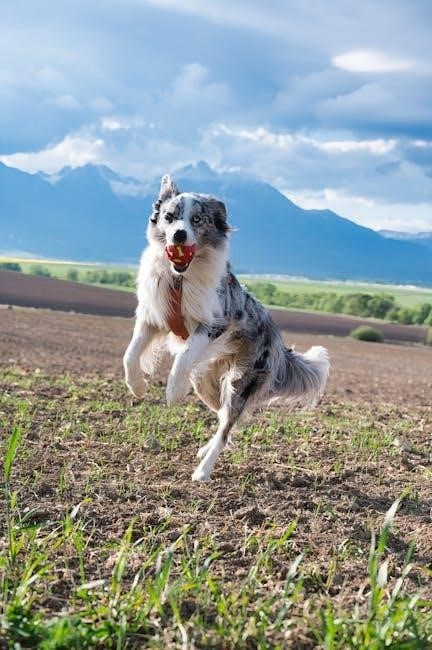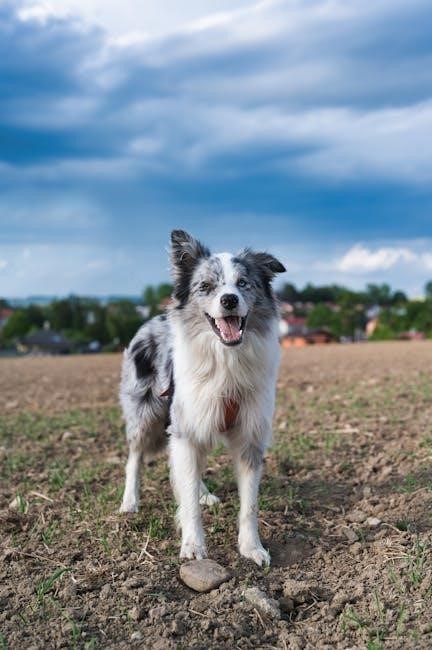Hypothyroidism is a common endocrine disorder in dogs, causing metabolism slowdown. It leads to symptoms like weight gain, skin issues, and lethargy. Levothyroxine treats this condition effectively.
Understanding the Condition and Its Treatment
Hypothyroidism in dogs occurs when the thyroid gland doesn’t produce enough hormones, leading to metabolic slowdown. Symptoms include weight gain, dry skin, and lethargy. Levothyroxine is the primary treatment, replacing missing hormones.
The medication works by mimicking natural thyroid hormones, restoring normal metabolism. Dosage is tailored to each dog’s needs, typically starting at 0.02 mg/kg daily. Regular monitoring ensures effectiveness and prevents side effects. A dosage chart by weight helps owners administer the correct amount, ensuring optimal treatment outcomes for their pets.
What is Levothyroxine?
Levothyroxine is a synthetic thyroid hormone used to treat hypothyroidism in dogs. It mimics natural hormones, restoring normal metabolism and alleviating symptoms like weight gain and skin issues.
Overview of the Medication and Its Role in Canine Health
Levothyroxine is a synthetic thyroid hormone replacement medication FDA-approved for treating hypothyroidism in dogs. It works by mimicking the natural hormone thyroxine, essential for regulating metabolism, energy levels, and overall bodily functions. In canine health, levothyroxine is critical for restoring normal metabolic activity, improving skin health, and addressing issues like weight gain and lethargy. Proper dosing, often guided by a weight-based chart, ensures effectiveness and prevents complications. Regular monitoring by a veterinarian is crucial to maintain the right balance and ensure the medication supports the dog’s overall well-being.

Levothyroxine Dosage for Dogs: General Guidelines
Levothyroxine dosage for dogs typically starts at 0.02 mg per kg daily, given once or twice. Adjustments are made based on the dog’s response and veterinary guidance.
Standard Starting Dose and Factors Influencing Dosage
The standard starting dose of levothyroxine for dogs is typically 0.02 mg per kg of body weight daily, administered once or twice. However, this dose can vary based on the dog’s specific needs, age, and overall health. Factors such as the severity of hypothyroidism, the dog’s weight, and individual response to the medication play a crucial role in determining the appropriate dosage. Veterinarians may adjust the dose after monitoring the dog’s progress through blood tests and physical exams. Regular follow-ups ensure the dosage remains effective without causing potential side effects, making personalized veterinary guidance essential for accurate treatment.
Levothyroxine Dosage Chart for Dogs by Weight
A levothyroxine dosage chart for dogs by weight provides a quick reference guide. The standard dose ranges from 0.02 mg per kg daily, adjusted based on individual needs and veterinary guidance.
How to Use the PDF Chart for Accurate Dosing
To use the levothyroxine dosage chart for dogs by weight effectively, locate your dog’s weight on the chart and match it to the corresponding dosage. Ensure accuracy by following these steps:
- Identify your dog’s precise weight in kilograms or pounds.
- Locate the weight range in the chart and find the recommended dosage.
- Adjust the dose as guided by your veterinarian based on your dog’s response and blood test results.
- Administer the medication as directed, typically once or twice daily.
This chart provides a clear, precise guide to ensure safe and effective treatment for hypothyroidism in dogs. Always consult your vet for personalized adjustments to maintain your dog’s health.

Importance of Monitoring and Adjusting Dosage
Regular blood tests and veterinary check-ups are crucial to ensure the dosage remains effective and safe. Adjustments may be needed based on the dog’s condition and weight changes.
How to Ensure the Correct Dosage for Your Dog
To ensure accurate levothyroxine dosing, use a weight-based chart and consult a veterinarian. Start with the standard dose of 0.02 mg/kg daily, adjusting as needed. Monitor your dog’s response and schedule regular blood tests to verify thyroid hormone levels. Adjustments may be necessary based on changes in weight, age, or health. Consistency is key; avoid missing doses to maintain steady hormone levels. Always follow veterinary guidance to tailor the dosage for your dog’s specific needs. Accurate dosing ensures effective treatment and prevents complications, safeguarding your dog’s long-term health and well-being.

Safety Guidelines for Levothyroxine Use in Dogs
Avoid overdosing by following the prescribed dosage. Monitor for signs of hyperthyroidism, such as rapid heart rate or restlessness. Administer as directed to ensure safe, effective treatment.
Preventing Overdose and Potential Side Effects
Preventing overdose and side effects requires careful monitoring of your dog’s levothyroxine dosage. Always follow the prescribed dose from your veterinarian, as overdosing can lead to symptoms like hyperthyroidism, including rapid heart rate, restlessness, or weight loss. Regular blood tests are essential to ensure thyroid hormone levels remain balanced. Watch for signs of overmedication, such as panting, hyperactivity, or increased appetite. If you suspect an overdose, contact your vet immediately. Adjustments to the dosage should only be made under professional guidance to avoid complications. Consistent monitoring ensures safe and effective treatment for your dog’s hypothyroidism.

Common Factors Affecting Levothyroxine Dosage
A dog’s weight, age, overall health, and individual response to medication are key factors influencing levothyroxine dosage adjustments, requiring personalized treatment plans for optimal efficacy.
Weight, Age, and Health Status of the Dog
The dosage of levothyroxine for dogs is significantly influenced by the dog’s weight, age, and overall health. Typically, the starting dose is 0.02 mg/kg daily, adjusted based on individual response. For overweight dogs, the dose may be calculated using their ideal weight to avoid overmedication. Age also plays a role, with senior dogs sometimes requiring lower doses due to reduced metabolism. Additionally, underlying health conditions, such as kidney or liver disease, can impact how the medication is tolerated. Regular monitoring and veterinary guidance are essential to ensure the dosage remains effective and safe for the dog’s specific needs.
Consulting a Veterinarian for Customized Dosage
A veterinarian tailors levothyroxine dosage based on a dog’s weight, health, and response, ensuring accuracy and safety through regular check-ups and blood tests.
The Role of Professional Guidance in Treatment
Professional guidance is essential for effective and safe treatment. Veterinarians use their expertise to tailor levothyroxine dosage, ensuring it meets the dog’s specific needs. Regular blood tests monitor thyroid hormone levels, helping adjust doses accurately. A personalized treatment plan prevents under- or over-medication, optimizing health outcomes. Vets also identify underlying conditions that may affect dosage requirements. Their guidance ensures the treatment is both effective and safe, avoiding potential side effects. Consulting a vet regularly is crucial for managing hypothyroidism successfully and maintaining the dog’s overall well-being.
Levothyroxine is a vital treatment for hypothyroidism in dogs. Always follow a vet’s guidance for accurate dosing; Monitoring ensures effectiveness and prevents complications. Regular check-ups are essential.
Key Takeaways for Pet Owners
For pet owners, understanding levothyroxine dosage is crucial for managing hypothyroidism in dogs. Always consult a veterinarian for personalized dosing based on weight and health. Use a dosage chart as a guide but tailor it to your dog’s needs. Monitor your dog’s response and adjust as directed. Regular blood tests ensure proper thyroid levels. Never deviate from prescribed dosages to avoid side effects. Patience is key, as finding the right dose may take time. Consistent monitoring and vet guidance ensure your dog’s well-being and effective treatment of hypothyroidism. Always prioritize professional advice for accurate and safe medication administration.
